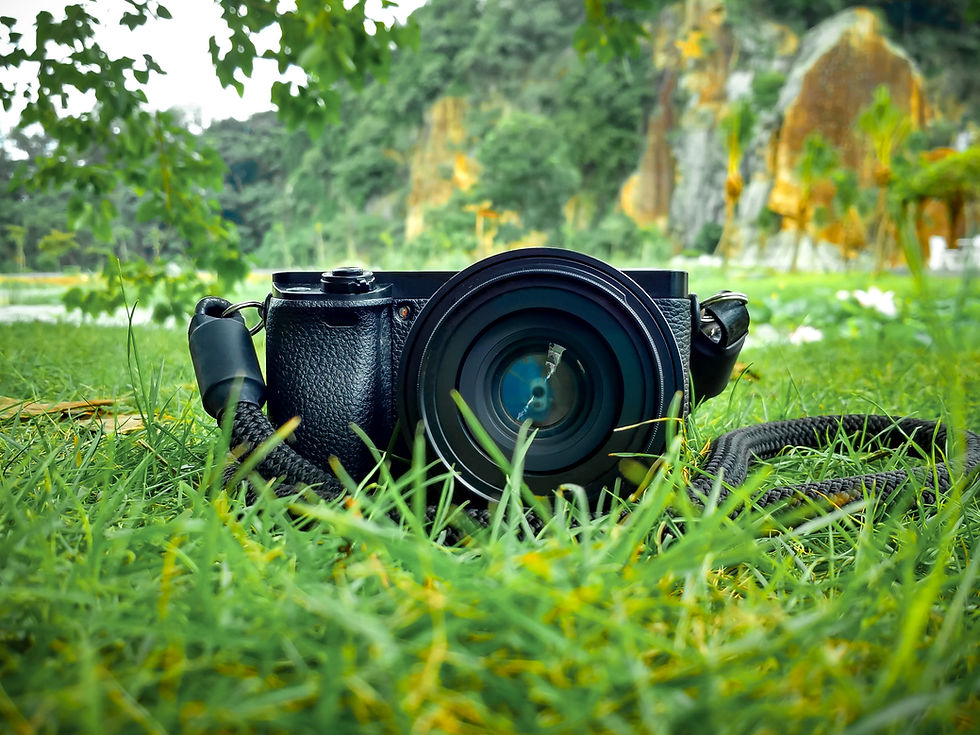The Ultimate DSLR Camera Comparison.
- The Moolah Team
- Jul 2, 2023
- 7 min read
In this blog post, we will compare and review different DSLR cameras, including their features, image quality, performance, and price, to help readers find the best camera for their photography hobby or profession.
I. Introduction
DSLR cameras are powerful tools that allow photographers to capture stunning images with precision and detail. Choosing the right camera can be a daunting task, especially for beginners or those looking to upgrade their equipment. In this ultimate DSLR camera comparison, we will provide an in-depth review of various DSLR cameras, including their features, image quality, performance, and price.
As you navigate through the world of DSLR cameras, you will find that there are a multitude of options available from different manufacturers. While some may prefer a particular brand, it is essential to understand what features to look for in a DSLR camera, regardless of the manufacturer. This blog post will provide a comprehensive guide to help you choose the best DSLR camera for your photography needs.
We will examine different aspects of DSLR cameras, such as the camera body, sensor, lens, autofocus, image quality, performance, and price. By the end of this post, you will have a thorough understanding of what to look for in a DSLR camera and be able to make an informed decision when purchasing your next camera.
This guide is suitable for all levels of photographers, from beginners to professionals. If you're new to DSLR cameras, you'll find the explanations of technical terms and features helpful. If you're a seasoned photographer, this guide will help you evaluate different DSLR cameras and choose the best one for your specific needs.
Whether you're a hobbyist, a professional photographer, or somewhere in between, a good DSLR camera is an essential tool for capturing high-quality photos. In the next sections, we will delve into the different aspects of DSLR cameras, and you'll learn everything you need to know to make an informed decision when buying a DSLR camera.

II. Camera Body and Design
The camera body is the foundation of any DSLR camera. It determines the size, weight, and durability of the camera. When it comes to choosing a DSLR camera, the camera body's design and construction are essential factors to consider.
Most DSLR cameras have a similar basic design, with a rectangular shape and a grip to hold the camera. However, some models have additional features, such as weather sealing, articulating screens, or built-in WiFi.
Weather sealing is an essential feature for photographers who shoot in extreme weather conditions. A camera with weather sealing will be able to withstand rain, dust, and other elements, making it ideal for outdoor photography. However, weather sealing may add to the camera's weight and cost, so it's important to weigh the benefits against the price.
An articulating screen is another feature that can be useful for photographers who need to shoot from different angles. An articulating screen can be tilted or rotated, allowing you to shoot from high or low angles, or from awkward positions. This feature is especially useful for videographers who need to capture footage from different angles.
Built-in WiFi is another feature that is becoming increasingly popular in DSLR cameras. This feature allows you to connect your camera to a smartphone or tablet, making it easy to transfer photos and videos wirelessly. It can also be useful for remote shooting, where you can control your camera from your phone or tablet.
When it comes to camera body construction, most DSLR cameras are made of plastic or metal. Plastic cameras are generally lighter and less expensive, while metal cameras are more durable and can withstand more wear and tear. However, metal cameras may be heavier and more expensive.
In terms of camera size, it's important to consider the size of the camera body in relation to the size of your hands. A camera that is too small or too big for your hands may be uncomfortable to use, leading to shaky shots and other issues.
In conclusion, the camera body and design are crucial factors to consider when choosing a DSLR camera. The features and construction of the camera body will determine the camera's durability, weight, and overall functionality. When choosing a camera body, it's important to consider your specific needs and preferences, such as shooting conditions, angle flexibility, and size.

III. Image Quality
Image quality is one of the most important factors to consider when choosing a DSLR camera. The quality of the images produced by a camera is determined by several factors, including the sensor size, resolution, ISO range, and image processing capabilities.
Sensor size is a crucial factor in determining the quality of the images produced by a camera. The larger the sensor, the more light it can capture, resulting in higher image quality. Full-frame sensors are the largest sensors available in DSLR cameras, followed by APS-C and Micro Four Thirds sensors.
Resolution is another crucial factor in determining image quality. Resolution refers to the number of pixels in an image. Cameras with higher resolutions will produce sharper and more detailed images. However, higher resolutions also mean larger file sizes, which can be a challenge when it comes to storage and processing.
ISO range is another important factor in determining image quality. ISO refers to the camera's sensitivity to light. Cameras with a wider ISO range will be able to capture more light, resulting in better image quality in low light conditions. However, higher ISOs can also result in more noise in the images, so it's important to find a balance between ISO range and image quality.
Finally, the image processing capabilities of a camera can also affect image quality. Some cameras come with advanced image processing features, such as noise reduction, sharpness adjustment, and colour correction. These features can help improve the overall quality of the images produced by a camera.
In conclusion, image quality is a crucial factor to consider when choosing a DSLR camera. Sensor size, resolution, ISO range, and image processing capabilities are all important factors that can affect image quality. When choosing a camera, it's important to consider your specific needs and preferences, such as shooting conditions and desired image quality, to find the camera that best suits your needs.

IV. Performance
Performance is another important factor to consider when choosing a DSLR camera. Performance refers to the camera's speed, autofocus capabilities, and shooting modes.
Speed is an important factor to consider if you're planning on shooting fast-moving subjects, such as sports or wildlife. Cameras with faster burst rates will be able to capture more images per second, giving you a better chance of capturing the perfect shot. Additionally, cameras with larger buffer capacities will be able to capture more images before slowing down.
Autofocus capabilities are also important for capturing fast-moving subjects. Cameras with more autofocus points will be able to track subjects more accurately, resulting in sharper images. Additionally, cameras with advanced autofocus features, such as eye detection, will be able to track subjects more accurately in challenging shooting conditions.
Finally, shooting modes can also affect a camera's performance. Cameras with a variety of shooting modes, such as portrait, landscape, and sports modes, will be able to adapt to different shooting situations more easily. Additionally, cameras with manual shooting modes will give you more control over your images, allowing you to customize your settings for specific shooting conditions.
In conclusion, performance is an important factor to consider when choosing a DSLR camera. Speed, autofocus capabilities, and shooting modes are all important factors that can affect a camera's performance. When choosing a camera, it's important to consider your specific needs and preferences, such as shooting style and subject matter, to find the camera that best suits your needs.

V. Price
Price is a crucial factor to consider when purchasing a DSLR camera. Cameras can vary greatly in price, from a few hundred dollars to several thousand dollars. It's important to consider your budget and your photography needs when choosing a camera.
The price of a DSLR camera will depend on its features, performance, and brand. High-end cameras from reputable brands such as Canon and Nikon will typically be more expensive than entry-level cameras from less well-known brands.
When considering price, it's important to remember that the cost of the camera is just the beginning. Additional costs can include lenses, memory cards, and other accessories. These costs can add up quickly, so it's important to consider them when determining your budget.
It's also important to consider the long-term value of the camera. A higher-priced camera with advanced features and better performance may last longer and produce better-quality images than a cheaper camera. This can result in cost savings over time by not having to replace the camera as frequently.
When shopping for a DSLR camera, it's important to do your research and compare prices from multiple retailers. Online retailers such as Amazon and B&H Photo Video often offer competitive pricing and have a wide selection of cameras and accessories.
In conclusion, price is an important factor to consider when purchasing a DSLR camera. It's important to consider your budget and your photography needs when choosing a camera, and to remember that the cost of the camera is just the beginning. Additional costs such as lenses and accessories should also be considered when determining your budget. It's also important to consider the long-term value of the camera when making your decision.

VI. Conclusion
In conclusion, choosing the right DSLR camera can be a daunting task, but by considering the factors discussed in this article, you can find a camera that meets your photography needs and fits within your budget.
When comparing DSLR cameras, it's important to consider the camera's features, image quality, performance, and price. Different cameras will have different strengths and weaknesses in these areas, so it's important to determine which factors are most important to you and prioritize accordingly.
Some of the top DSLR cameras on the market today include the Canon EOS 5D Mark IV, Nikon D850, and Sony Alpha a7R IV. These cameras offer advanced features, excellent image quality, and top-notch performance, but they come with a high price tag.
For those on a budget, entry-level cameras such as the Canon EOS Rebel T8i or Nikon D3500 offer great value and quality for a more affordable price.
Ultimately, the best camera for you will depend on your individual needs and preferences. Consider the type of photography you'll be doing, your level of experience, and your budget when making your decision.
When purchasing a DSLR camera, it's also important to consider accessories such as lenses, memory cards, and camera bags. These accessories can enhance your photography experience and help you get the most out of your camera.
In summary, by doing your research, comparing cameras, and considering your individual needs, you can find a DSLR camera that meets your expectations and allows you to capture stunning photos for years to come.
Thanks for taking the time to read our Ultimate DSLR Camera Comparison. We hope that this article has provided you with valuable insights and helped you make an informed decision when choosing a DSLR camera. If you enjoyed this post, be sure to subscribe to our newsletter to stay up-to-date with the latest photography tips and tricks. Thanks again, and happy shooting!
From Moolah.







Comments